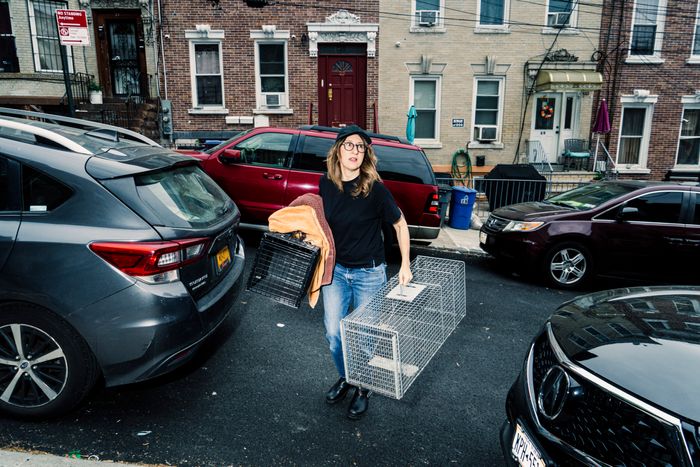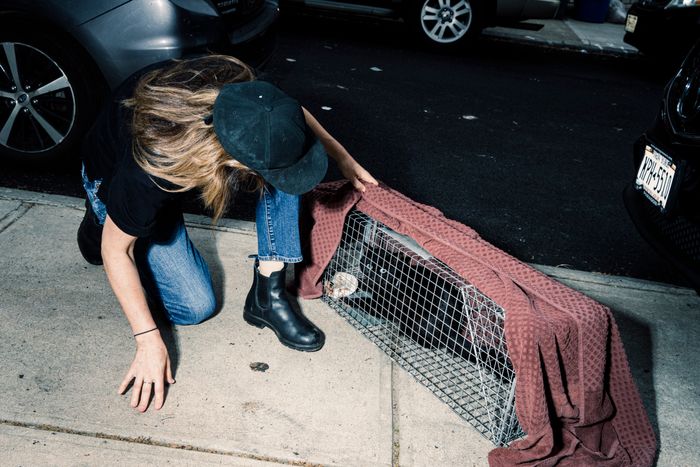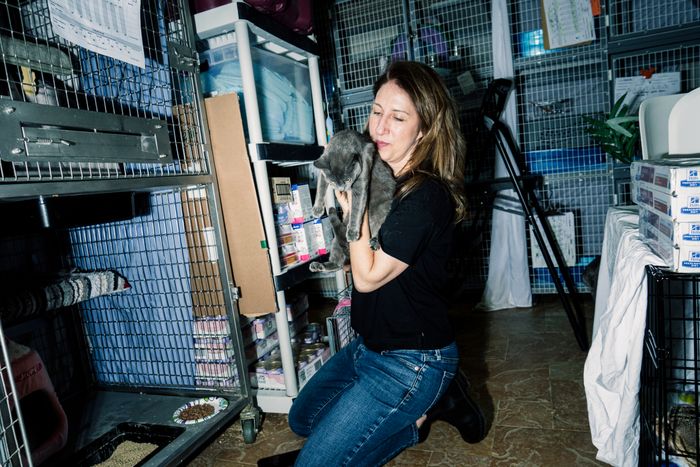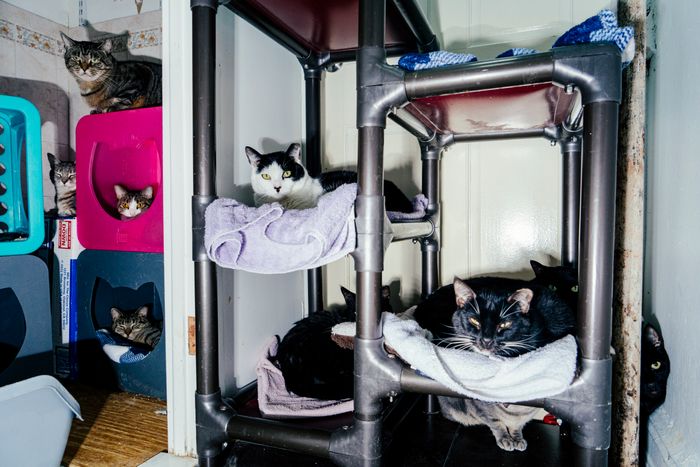TNR Volunteers Are Fighting Waves of Feral Cats in New York

Cats eating at a managed feral cat colony in Greenpoint, Brooklyn.
Photo: Jutharat ‘Poupay’ Pinyodoonyachet
On a recent Sunday afternoon, Lauren Caulk was in her “cat room,” a tiled, closet-size space outfitted with a drain. A litter of kittens had just moved in. They were stumbling over each other, wet pink eyeballs sunken into their tiny heads. One was almost entirely blind, another had ulcers Caulk was hoping the vet could shave off. “All this one seems to know how to do is face-plant in his food,” Caulk said, pointing to a woozy kitten she’d named Raisin Bread. She was giving him sponge baths several times a day.
In crates stacked against the walls of the cat room nestled a handful of adults: A rescue from a house fire with purple gums from CO² inhalation, a cat with some kind of leg condition. Caulk had pulled one of them out of a couch herself. As she introduced me to each cat, she ran down her daily routine: Clean half a dozen litter boxes, feed the cats, dole out medication in “nine to 15 little bowls,” send a round of emails to vets in the hopes of getting discounted checkups and scans. “And then, of course, I’ll try to get some content,” she says. “Because if there’s no content, we’re not getting people’s freaking coffee money to donate towards our, like, exploded eyeball surgery.”
Until around 2016, Caulk lived a fairly normal life for a person living in Brooklyn with a fine-arts degree. She managed a Mexican restaurant and worked as a photo assistant. She rented an apartment in Fort Greene and shopped at the farmers’ market. She participated in group photography shows. She cultivated rare forms of jasmine. And then, about a decade ago, she found a relatively cheap house on the market in Ocean Hill, a section of Bed-Stuy bordered by Brownsville and East New York. Soon after she moved in, she realized that the house was already sort of occupied. A colony of 25 feral cats lived in her backyard, seemingly subsisting on whatever scraps they could find.
And then that spring mating season began. The cats yowled and fought. The scent of male cat, like ammonia, seeped into her living room. “You couldn’t really have your back windows open because they were fighting and fucking all the time,” she says. When she complained about the issue to one of her new neighbors, she mentioned she’d heard about something called “trap, neuter, and return,” a supposedly humane method of managing sprawling populations of feral cats. She was going to take a city-run class to get certified and handle the cats that had taken up residence in her own yard. Did Caulk want to come too?
Becky Wisdom carries cages in Cypress Hill, Brooklyn, before trapping a cat.
Photo: Jutharat ‘Poupay’ Pinyodoonyachet
Wisdom checks a cage with a trapped cat in Cypress Hill, Brooklyn.
Photo: Jutharat ‘Poupay’ Pinyodoonyachet
There have likely never been so many cats living on the streets of New York. Some estimates put the number around 500,000; others closer to a million. The problem is especially visible in low-income neighborhoods and the outer-boroughs, where there are more derelict spaces for the animals to roam. In Bushwick, the cats share meals with raccoons in vacant warehouse lots. In Sheepshead Bay, they lurk in condemned homes. But stray cats have been a problem for decades and one the city has never quite been able to manage. The USDA has vacillated over whether to call them an invasive species, which makes sense — they kill native birds, harbor rabies, and their feces can contain hundreds of millions of cells known to spread infectious disease. (And unneutered males are known for the noxious smell of their piss, which they unleash freely on anything in sight.) They’re health hazards and a quality-of-life issue in dense cities like New York.
Until fairly recently, the responsibility for catching and determining the fates of stray cats officially fell to a network of beleaguered city-affiliated shelters, if the responsibility fell to anyone at all. A 1998 story in this publication described an underfunded, chaotic agency providing what was essentially “assembly-line euthanasia,” which could kill nearly 3,500 animals in a single month. Facing pressure from animal-welfare advocates — along with a string of stories about neglected shelter kittens being smothered or frozen to death — by the mid-aughts the city announced its intention to become a no-kill system. Luckily for New York, and other cities struggling to contain their cat populations, the same shift in public opinion that made mass euthanasia less viable also generated an alternative: trap, neuter, return (TNR), a movement championed for decades by animal advocates that took off as Americans began thinking of pets as something closer to family members. With TNR, volunteers could trap feral cats, neuter them so they could no longer procreate (and, while they had them, give them vaccinations and bring them back to some semblance of health), then return the animals to whatever home they were accustomed to, safe in the knowledge this represented the most humane way to deal with a massive infestation of creatures that by most accounts shouldn’t exist in the first place.
In the more ambitious versions of TNR, these same softhearted people would then “monitor” the cat colonies, feeding the happily roaming, properly neutered members, retrapping them and getting them medical attention should a serious need arise — and starting the process again when a new, unfixed cat inevitably showed up. Cats that weren’t entirely feral would be adopted out. The problem, of course, is that none of this is easy. Cats regress quickly in the outdoors, and even if they’re not feral, they need time to warm up to humans. This takes people with both patience and a willingness to suffer through scratches and escape attempts in the interim. Managed colonies functionally represent dozens of half-wild outdoor pets permanently at the mercy of speeding cars and other hazards — a lifetime of food and health care, distributed by volunteers, in the least ideal conditions possible. But through the late ’90s and early aughts, animal-welfare organizations — like the Maryland-based Alley Cat Allies, for instance — worked to ensure the general public knew that, at the very least, TNR was the very best possible option. They partnered with local governments, held mass spay-neuter events, and published information about TNR’s efficacy. It’s easy to see why it took off. Who wants city-sanctioned kitten murders?
But over the past few years, TNR has become more controversial. Opponents of TNR — like obsessive birder Jonathan Franzen, who published nearly 9,000 words on the subject in The New Yorker earlier this year — have a handful of common points. TNR, they say, is disastrous for local wildlife; it normalizes a public nuisance without significantly reducing its population; it increases the likelihood of disease, and it perpetuates a cycle in which kittens will certainly be born into horrific conditions. And after all of that, it’s not even particularly useful. Some research suggests that volunteer-based trapping and neutering makes too little a dent to be effective. (Organizations supporting TNR, of course, are quick to point to research that refutes this.) The ASPCA and the Humane Society of the United States endorse TNR. PETA does not.
Still, New York’s shelter network just does not have the capacity to hold, then rehome hundreds of thousands of potentially feral animals. Especially as, over the past few years, the cat population has sharply increased. “We’re seeing dumped cats everywhere. Kittens put outside in boxes. It’s worse than ever,” the founder of a Flatbush veterinary clinic told the New York Post last year. Cat advocates attribute the booming stray population to an increase in the cost of living — rising rents, inflation, spay-neuter appointments that can cost over $500 at for-profit vets, forcing owners to make a decision between taking care of their cats and taking care of their human kids. Last summer, the underfunded city-associated shelter system, the Animal Care Centers of New York, put a temporary hold on taking new pets — they were at “critical capacity,” they said. In the meantime, the only solution anyone has been able to reliably recommend is TNR — a handful of organizations offer training programs and discounted services aimed at increasing the number of people interested in learning how to capture a cat or two after work.
The ASPCA says it has more than 800 actively certified New Yorkers on its rolls (a number, by the way, that grew significantly during the pandemic, when people were at home, bored, and surveying the cats marching past their windows, then shrunk when those same people went back to work). The varied cat-rescue network across the city includes large organizations like Flatbush Cats, a nonprofit that recently built its own clinic, and influencer-ish rescues like Heidi Wrangles Cats, who posts glossy Instagram tutorials wherein cats creep tentatively into cages in her Brooklyn backyard. (“Our newest crew of six sick kittens that were left in an open carrier outside of a park in Bed Stuy,” she captioned a recent post of bleary-eyed animals in a cat carrier. “I’m in love with this crew, and am naming them Class Clown, Goofball, Birdbrain, Airhead, Space Case, and Silly Goose.”) She has 416,000 followers, to whom she also sells Heidi Wrangles Cats–branded baseball T-shirts and water bottles. It’s a fragile ecosystem. Heidi Wrangles, and Lauren Caulk, and people much like them — a largely white, mostly female population living in the boroughs with feral-cat problems — are the only thing standing between New York’s neighborhoods and an endless stream of underfed, disease-ridden kittens.
At first Caulk trapped cats and adopted the friendly ones out to neighbors and friends. She took a few of them herself. (At one point, she accidentally gave her mother a skittish, slightly feral cat, something she says won’t happen again.) It was a way to embed herself in her new neighborhood, which in the early 2010s was far from the Bed-Stuy gentrification line that would eventually crawl steadily east; it was definitely considered remote by her friends. But soon, the other cat people in her neighborhood started passing her number around. They’d call her if they needed TNR services in their backyard and also if they wanted advice about their own cats. She quickly realized she was out of her depth. Some of the cats she trapped had serious medical issues — complicated infections, organ failure. She might have known how to trap a cat, but she certainly didn’t know how to treat and triage an animal with a torn diaphragm. So she wrote to two rescuers in Brooklyn, Chris Glazier of Bushwick Street Cats and, eventually, Becky Wisdom of Greenpoint Cats. Cat people tend to be friendly with other cat people: Glazier started walking over to Caulk’s apartment with special medication for her serious cases; Wisdom gave her tips on where to get the best veterinary deals. As she gained experience, she began taking in more cats, then more. When Caulk first bought the house in Ocean Hill, her grandfather had helped her design the small space between her living room and kitchen so she could grow plants. But in the years after she moved in, pots of jasmine were slowly replaced by cat trees and stacks of crates — and a rotating cast of sick animals. “That’s one big benefit,” she says. “There’s no landlord telling me, ‘No more cats.’”
Though she’d just intended to handle the yowling in her backyard, she ended up turning the space into a comfortable place for the truly feral animals to hang around permanently. In between her outdoor furniture and vining plants, she retrofitted coolers with straw bedding the cats could sleep in during winter nights and set up a feeding area under the patio; she put out food every day. Between the backyard colony and her own rescues, Caulk could spend 40 hours a week tending to the cats. She started making fewer trips to the farmers’ market; spending more time at home. In 2016, she says, she was trapping and neutering between 20 or so animals a year herself. All of them were microchipped — it made it easier to keep track of them, plus it eliminated a step for owners if they got adopted out. One day that year, Caulk got a call from a local veterinarian. Her lost cat, the vet said, had been found. Panicked, Caulk looked around her house. All her house cats were just where they should be. “And then I was like, Ohhhh, that’s Queen Elizabeth” — one of the cats living in the colony in her backyard. She insisted on speaking to the people who’d “found” Queen Elizabeth. As it turned out, one was a software engineer, Ola Mackow, living in a house near hers with an adjoining backyard. The couple had been feeding Queen Elizabeth on their deck for months and bringing her indoors.
Caulk asked to speak to Mackow. Over the phone, Caulk explained that Queen Elizabeth was part of her backyard colony — and while she had her, she started extolling the gospel of TNR more generally. Mackow loved cats, as it turned out. She was intrigued. So the pair started going out on evening TNR excursions in the empty lots of Ocean Hill. Later that year, she helped Caulk file the paperwork for the nonprofit that would become Ocean Hill Cats. By 2022, the team had a half-dozen volunteers, including one woman working remotely from Idaho. (She handled administrative work like interviewing potential adopters.) By that point, they were caring for around 200 stray cats a year — a combination of neighborhood cats and serious medical cases from areas like Bensonhurt and East New York, many of whom were rehabilitated and adopted out. They set up a Slack channel and Airtable to coordinate medications and monitor kittens’ health. She was relieved to have a proper organization, other people to talk to about all of this, she says. It’s not something she likes to discuss with people outside the rescue world, even though it takes up as much space in her life as her actual full-time job. “You can’t talk to your family about it, you can’t really talk to your friends,” she says. “Everyone thinks I’m a crazy person.” Her husband is accommodating, but she makes a point to keep everything confined to the cat room and to keep everything clean. “I think most people’s partners are kind of like yikes about it,” says Caulk. “I’ve heard about a million breakups over this stuff.”
Wisdom holding a cat at Puppy Kitty NYC in Middle Village, Queens, before it is sent to be spayed.
Photo: Jutharat ‘Poupay’ Pinyodoonyachet
Rescued free-roaming cats that have been spayed and neutered at Puppy Kitty NYC.
Photo: Jutharat ‘Poupay’ Pinyodoonyachet
Ocean Hill Cats, like most small New York City rescues, relies almost entirely on donations and volunteer labor to carry out its work. Yes, a handful of nonprofits and city-affiliated programs offer free spay/neuter appointments to registered rescues, but the slots are so difficult to secure that organizations form teams of volunteers to log on to the website at 6 a.m. sharp on the day they are released. Many rescues standardize the cost of adoption to avoid competition among themselves: $125 for an adult cat, $300 for a pair of kittens. The inflow of cash for adoptions barely makes a dent in what they need for medications, and surgeries, and everything else; the most reliable way to succeed as a smaller rescue is to develop an Instagram following, post photos of cute animals in dire straits, and wait for donations to roll in. Last year, says Caulk, Ocean Hill Cats’ operating expenses came out to just under $52,000, a little over $43,000 of which went to medical care. Greenpoint Cats, operated by Caulk’s mentor Becky Wisdom, is one of the better-funded organizations in Brooklyn, likely because the residents of Greenpoint have a little more cash to throw around than those in Ocean Hill. Plus Wisdom, who has a career in advertising, works all the angles. She places laminated posters with QR codes soliciting donations near the colonies she keeps.
In 2022, Greenpoint Cats made $20,850 from adoption fees and $120,814 in donations. Around $115,000 of that went to medical care for fostered and adoptable cats, $17,744 to medical expenses and supplies related to TNR, and $1,810 for food for feral-cat colonies. And then there were the expenses for transportation to vets and fosters ($9,006), storage facilities for traps and supplies ($4,036), cleaning used towels and bedding ($555), and adoption advertising ($451). When I spoke to Wisdom, she lamented the picky eaters in her brood. There are 30 cats in colonies her team’s volunteers feed plus a consistent 60 or so that she’s put in foster homes. And cats are finicky, she says. “I swear dogs are easier to feed. They don’t change their mind every week about what they’re going to eat.”
The hardest part of cat rescuing, Wisdom likes to say, is other people. Over the spring, I spoke to a cat rescuer named Alexcia Hernandez, who operates in Cypress Hills. She told me she’d recently found six unfixed, semi-feral cats wandering the neighborhood. She put down a can of wet food for them on a neighbor’s stoop — only for the neighbor to promptly come outside and hurl the food in her face. Wisdom’s had plenty of similar experiences, she says. So has Caulk. Not too long ago, she took in two kittens, one with leukemia — an extremely communicable disease in the feline world — who’d been getting fed by a neighbor who didn’t have the resources to care for them. A few weeks later, the woman busted in her front door to demand the return of the kittens, having apparently learned about the “neuter” part of TNR. “She was like, I want them to go outside and have babies. I want them to have the female experience of being pregnant at least once.”
This can all make the city’s rescuer population a little — well, preachy. Last year, a well-meaning East Village resident posted on a local Facebook group that a corner deli’s cat was pregnant and the owners were looking for good homes for the kittens: “Stop by if you want a kitty!!” She wrote, only to find herself at the mercy of exasperated TNR advocates in the area, some of whom had apparently spoken to the owner the last time his cat gave birth. “A cat is a 20-year commitment, when you stop by, please tell him how important it is to get his cats spayed and neutered,” wrote one. “Otherwise he is encouraging a life of suffering, neglect, betrayal, struggle, and abuse absolutely no animal deserves!!!!”
In early June, a few new cats showed up unexpectedly at one of Greenpoint Cats’ managed colonies, an abandoned lot on Franklin and Oak packed with cat houses and junked cars. Wisdom didn’t know where they came from, but it didn’t really matter — one cat might mean two cats, and two cats could definitely mean kittens. Cats are able to give birth as young as four months, and they can get pregnant five times a year. Wisdom is known as a sort of trapping savant and has worked out a litany of creative methods: She once recorded a mother’s kittens crying and played the sound on a Bluetooth speaker under a trap in order to lure it in. (This worked.) But this Siamese was proving fussy. Every time she tried to trap it, it scattered. So she worked to slowly earn its trust: Every day for over a week, she walked over to the colony and placed wet food under an unset trap. When she decided to go back to try again, she invited me to tag along — though I was instructed not to look it directly in the eye, lest I scare it off. When we got to the colony, she deftly began doing the same thing she’s been doing countless times a week for the past seven years, since she — like Caulk — moved to a new neighborhood, found some cats in her backyard, and slid suddenly into running a 12-person cat-capturing organization. She placed more wet food down, tied a 20-foot string to a stick, used it to prop up a metal cage, waited for the Siamese to creep forward, then — quick! pulled the string. “Whew,” she said, putting a blanket over the cage and clicking her tongue at the cat. All that was left was to check to see if the Siamese was lactating, which would mean there were kittens nearby, which would mean more cats to trap. (The cat was not.) Until — Wisdom’s phone buzzed. She had a text from the local library: They had a cat that had just been surrendered. Could Wisdom come and pick it up this afternoon?
Caulk says she’s basically okay with the fact that TNR has eaten into her ability to do anything outside of work. These days she has a job that allows her to work from home, so she has time to tend to her brood — the backyard cats as well as three she’s brought inside permanently from her colony. (Caulk “retires” the elderly ferals from the backyard, letting them live their last months alive comfortably indoors.) A lot of her world revolves around the animals. She likes that she’s really good at it, that it keeps her involved with her neighbors. She’d recently taken the kittens I’d met to the vet; one had an eye removed, a pretty easy surgery in Caulk’s estimation given the eye is “kind of an external organ.” Four from the litter were in foster homes awaiting adoption. Two were sent to a foster, then promptly temporarily returned — they had a nasty case of ringworm. Now she’s treating them with medication and a sulfur lime bath that she has to mix herself. After the baths, the kittens have to drip dry, so Caulk puts tiny cones around their necks and places them on a heating pad.
Wisdom, who has a few years on her, and a few hundred cats, feels tired. A volunteer rescue force just can’t compete with the cats’ staggering reproduction rate citywide. And the closer you are to the cat problem, the more likely you are to experience a sense of futility. Once you start seeing the feral cats, Wisdom says, you realize they’re everywhere, slinking behind pizza shops and giving birth in crumbling walls. Recently, on the way to a neutering appointment, car stuffed with cat carriers, she came across a particularly sorry-looking colony and pulled over to set a few traps. She’s on the verge of being priced out of the neighborhood, but sometimes she doesn’t feel like she can leave — it’s unclear if Greenpoint Cats can sustain her already unsustainable workload without her. “If everyone that does this independently as volunteers went on strike,” she says, walking away from the abandoned lot, “it would be out of control in six months.” Cats everywhere, the smell of piss omnipresent, sick and dying animals crowding New York’s abandoned buildings and corner lots and community gardens and backyards. I think of a story Caulk told me about visiting an overgrown lot in East New York, dozens and dozens of cats staring down at her silently from the shrubs and low-hanging trees. “It’s a bottomless pit,” Caulk says. “And that’s why people get burnt out. They think they’re going to actually fix the problem.”
See All
Source link








